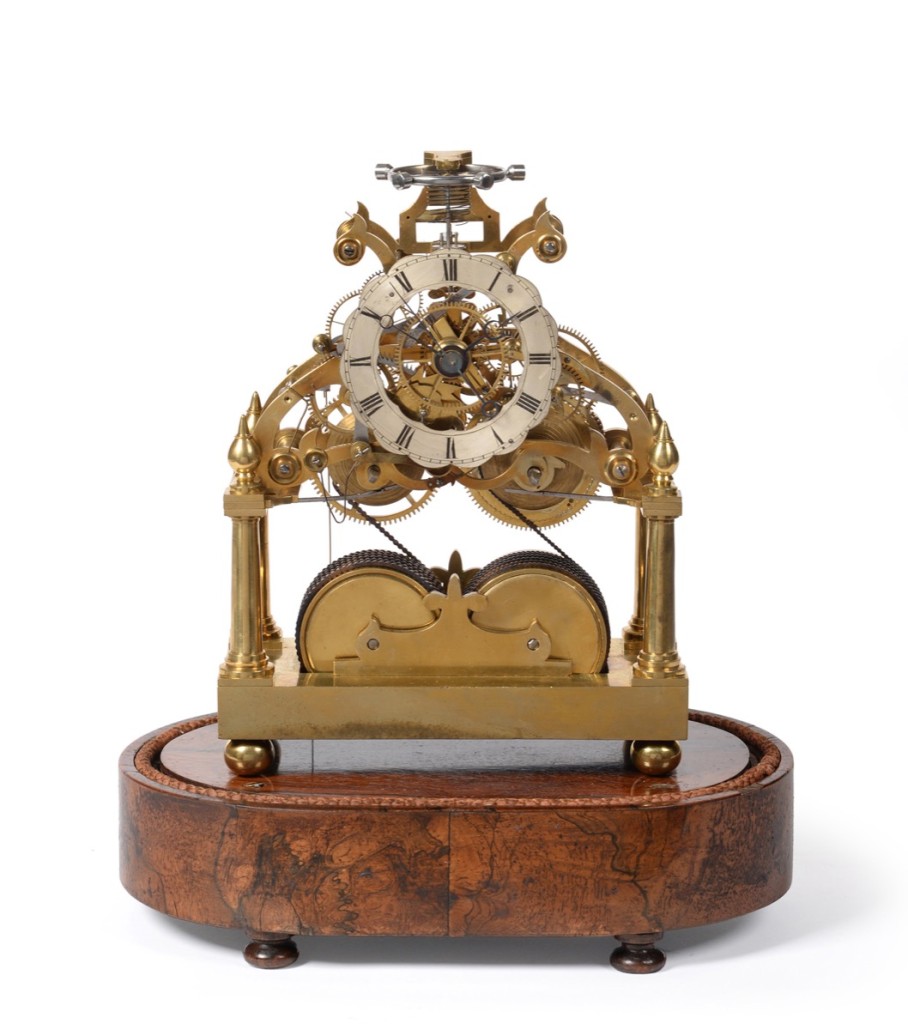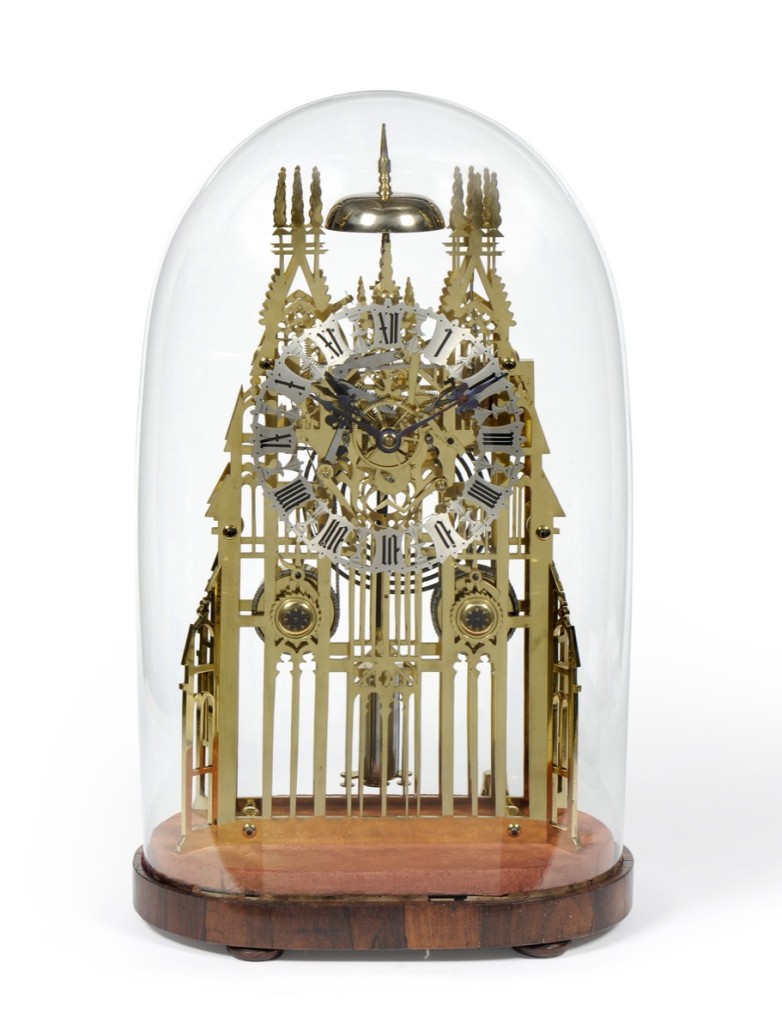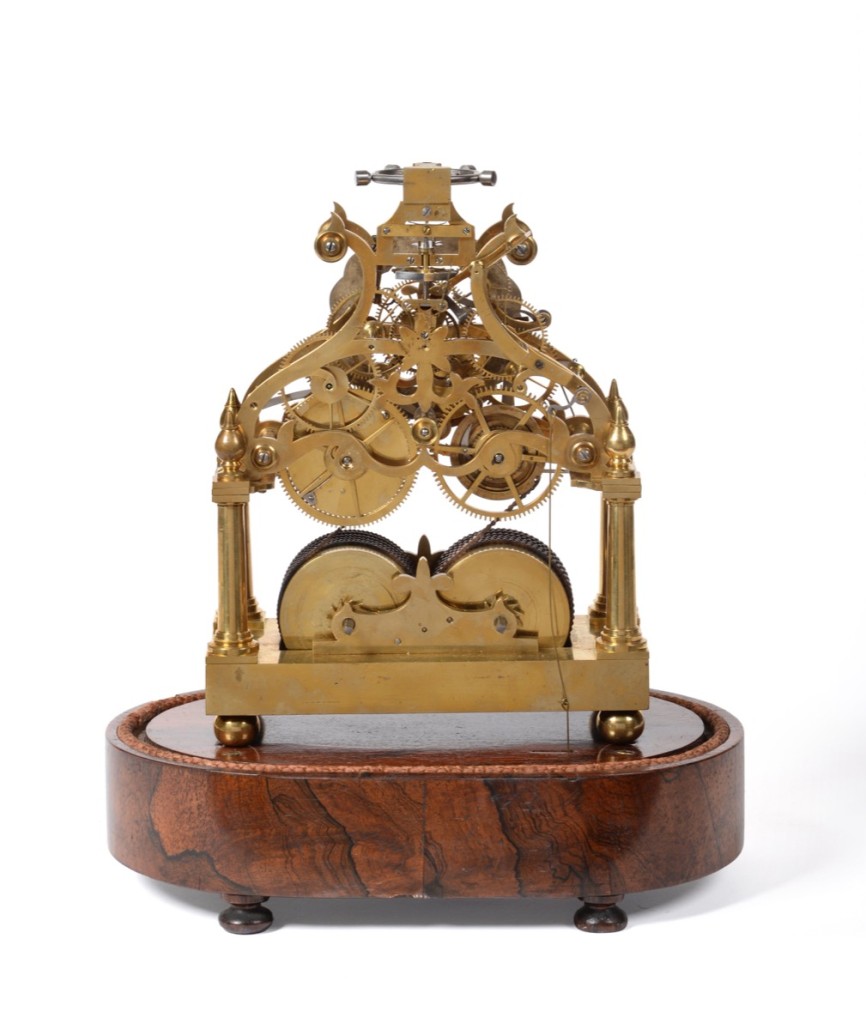
LONDON – It all started when my father and I started tinkering with an old wooden cuckoo clock he’d unearthed. Problem was it had no pendulum or weights. Actually, not a problem. The former was crafted from wire cut from a coat hanger pushed through the stem of a large coat button and weighted with modeling clay. The weights to make the thing tick and “cuckoo” were brown and red sauce bottles suspended respectively from each of the chains hanging from the clock.
Amazingly he coaxed it into working and I have been fascinated by anything mechanical large or small ever since. Among the most interesting among our own meager collection of clocks – to me anyway – is what collectors call a skeleton clock so called because its “bones” – the cogs, wheels springs and everything else that makes up its movement – are all clearly visible beneath a glass dome.
The Victorians loved glass domes. Wax fruit, dried flowers, fine china and glass and – perhaps less acceptable today, although sought after in some circles – stuffed birds and animals, all found a place in our great-grandparents’ drawing rooms.

The idea of putting fine clocks under a protective glass bubble enabled clockmakers to make timepieces without a case and thus show off their expertise. Consequently, the fashion for skeleton clocks was a shot in the arm for the ailing British industry in the third quarter of the 19th century.
Clocks whose works were at least partly visible had been around since about 1750. Glass panels were inset into the wooden and metal cases of all types of longcase, wall and bracket clocks, the maker being justly proud enough of his craftsmanship to want to share it with his customers.
However, the greater part of the often beautifully cut, machined and engraved works was hidden, seeing the light of day only when the clock’s hood was removed, in the case of the longcase, or, in bracket clocks, when access was gained through hinged doors or flaps.
The skeleton clock was originally a French invention and it is thought they were first made in this country as apprentice pieces. In other words, trainees were set the task of building a clock at the end of their apprenticeship that would prove their ability and expertise.
What better way than to cut away the dial and the plates so that the wheels in the trains and the workings of the escapement were in full view?

No doubt many were made as such a test, but the number is small by comparison with those produced simply because the new and fashionable idea proved highly popular at a time of fussy Victorian taste.
Purist clock collectors are sometimes critical of skeleton clocks since they echo the fussiness of the period. They argue that the clockmaker’s skill has been concentrated too much on decoration and embellishment of the movement than on actual timekeeping excellence.
Often, quite simple, single train movements were used that only tick and tell the time. Where a striking train is included, the hours are marked often only by a single chime from a hammer striking a bell, usually placed at the apex of the clock’s frame.
Consequently, prices of skeleton clocks have not yet achieved their potential. However, as a collector of clocks (not a purist) I consider the skeleton clock to be one of the most visually appealing.
An antique work of art that actually involves movement is so much more exciting than something that merely sits on a shelf. Watching the mechanical masterpiece record the minutes as they elapse is not only highly relaxing and restful, but also fascinating.
As you might expect, English skeleton clocks are robustly made using top quality polished brass and steel. Basically, they comprise two shaped and delicately pierced plates that support the movement sandwiched between them.
These plates give the clock its style: either graceful and elegant curves and scrolls resembling a Chinese pagoda or lyre shape, or else business-like angular and gothic, which came later in the clock’s development.

Some of the more outlandish examples of Victorian taste and excellence of workmanship occur in the latter. Victorian gothic is most definitely an acquired taste. It can be seen in notably in furniture that became architectural in design. The style is echoed in the skeleton clock.
The most complicated of all such gothic clocks are those copying some the country’s cathedrals, notably York Minster, Lichfield and, perhaps most impressive, Westminster Abbey.
The larger clocks these magnificent creations demanded also allowed the maker to include a strike train and a chiming train, although such examples are today rare and costly.
Two words of warning: first, take care of the glass dome … they break with alarming ease and replacing them is a much more difficult task. New domes are being manufactured, but they come in standard sizes for, often, nonstandard clock bases.
Finally, watch for modern copies. The skeleton clock continued to be made in relatively large numbers until about 1915. These days, with the increase in leisure time and interest in old things, amateur clockmakers and building new skeleton clocks using kits that can be bought over the counter.
If money was not an issue (it always is) I’d have left a bid on this amazing and incredibly rare skeleton clock sold at North Yorkshire auctioneers Tennants on Nov. 14.


It was made by James Condliff, who is regarded as one of the finest makers of skeleton clocks and regulators of the 19th century. He had premises at 32 Gerard St., Liverpool, from 1816-1827, and in Everton and Mount Vernon, before retiring in 1862.
Condliff’s skeleton clocks were individually handcrafted and no two are exactly alike. Only a small number are still in existence today.
The example in Tennants’ sale, which dates from about 1840, is an ornate prototype second series incorporating the first series four-column lower frame with a rectangular base and beautifully delicate upper scroll frame movement plates.
In addition to it striking the hours on a gong concealed in the rosewood veneered base, it also has a seconds hand, which I have never seen before on a skeleton clock. Thought to be one of only two like it, it fetched £15,000.
___
By CHRISTOPHER PROUDLOVE



